|
Report from
Europe
Rise in UK tropical wood and wooden furniture imports
In the first five months of this year the UK imported
168,200 tonnes of tropical wood and wooden furniture
products, 5% more than same period in 2024.
Import value in the first five months this year was US$442
million, 8% more in nominal terms (not accounting for
inflation) than the same period in 2024. Although imports
were slow in the first quarter this year, down 6% in
quantity terms compared to the final quarter of 2024, they
strengthened in April and May (Chart 1).
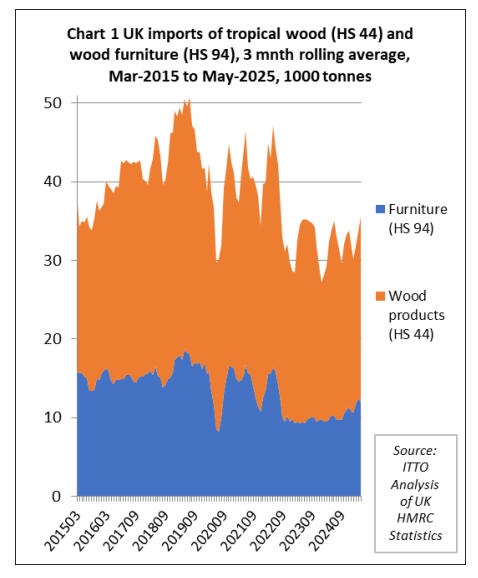
The overall rise in imports of tropical wood products in
the first five months of this year has been driven mainly by
wooden furniture and joinery products. There were only
marginal gains in imports of tropical sawnwood and
mouldings/decking, while imports of tropical plywood
have weakened once more.
Underlying the import gains are some improving signals
from the UK economy. The first quarter saw a stronger-
than-expected start, with 0.7% growth.
The U.K. has also managed, so far, to steer clear of the
trade wars after deciding not to retaliate against the U.S.
tariffs and reaching an early trade agreement with the
Trump Administration.
Construction sector indices for the UK, while pointing to
only moderate growth, are also more favourable than other
large European economies. The ‘Summer 2025 UK
Construction Market View’ report published on 30 June
by Arcadis, a global design and consultancy firm for
natural and built assets, includes a cautiously optimistic
outlook, with several key sectors beginning to scale up,
and projections suggesting that the construction industry is
growing faster than the wider economy.
The Arcadis report observes that “while sticky inflation
may slow the rate of interest rate cuts, there are early,
tentative signs of recovery. Orders have regained some
lost momentum, and industry sentiment is improving”.
Less positive is the news on consumer confidence in the
UK which took a sharp downturn in Q2 2025, according to
Deloitte’s latest Consumer Tracker, falling by 2.6% to
10.4%, which is the lowest level recorded since early
2024. The drop marks the first significant dip in sentiment
since October 2022, when inflation hit a 40-year high.
According to Deloitte “This drop in confidence signals a
weakening of consumers’ resilience, as concerns of a
slowing labour market have left consumers worried about
job security and income growth prospects, while persistent
inflation and a high cost of living have negatively
impacted sentiment towards personal debt.”
See:
https://www.arcadis.com/en-gb/news/europe/united-
kingdom/2025/6/arcadis-releases-summer-2025-uk-construction-
market-view-report
and
https://www.deloitte.com/uk/en/Industries/consumer/research/co
nsumer-tracker.html
Rise in UK imports of wooden furniture from tropical
continues
In the first five months of this year UK imports of wooden
furniture from tropical countries increased 17% to US$219
million while import quantity increased 16% to 57,900
tonnes. Tropical wooden furniture imports in the five-
month period increased particularly sharply from Vietnam
(+28% to US$123 million) and Malaysia (+11% to US$48
million), building on the momentum that built up in the
second half of last year. Imports increased at a slower pace
from India (+1% to US$21 million), and Indonesia (+3%
to US$19 million).
However, imports declined from Thailand (-20% to
US$3.2 million), and Singapore (-34% to US$1.4 million).
UK wooden furniture imports were negligible from all
other tropical countries during the first five months of this
year (Chart 2).
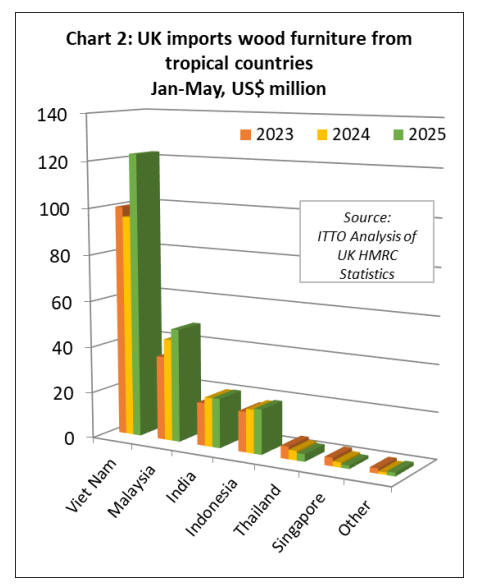
UK imports of tropical wood joinery products rise
sharply from Asia
Total UK import value of tropical joinery products
increased 2% to US$90 million in the first five months of
2025 and import quantity increased 7% to 31,800 tonnes.
Following a big increase in 2024, imports of these
products from the EU fell 27% to US$16 million in the
first five months of this year.
However, this was compensated by rising imports from
Malaysia (+26% to US$26 million), China (+31% to
US$12 million) and Vietnam (+58% to US$4.4 million).
Imports from Indonesia were US$42 million during the
five-month period, the same level as last year (Chart 3).

Large increase in UK imports of plywood from
Malaysia
In the first five months of this year, the UK imported
78,600 cu.m of tropical hardwood plywood, 4% less than
the same period last year. Import value fell more sharply,
by 8% to US$45 million. However, this was mainly due to
a decline in imports from China and the EU.
Direct UK imports of hardwood plywood from tropical
countries increased 15% to 58,700 cu.m in the five-month
period. Imports were up 49% to 33,400 cu.m from
Malaysia and up 43% to 2,400 cu.m from Paraguay. They
also increased from zero to 2,000 cu.m from Singapore.
These gains offset declines of 16% to 18,200 cu.m from
Indonesia and of 58% to 1,200 cu.m from Brazil. The UK
imported 17,400 cu.m of plywood with an outer layer of
tropical hardwood from China in the first five months of
this year, 37% less than in the same period last year. UK
imports of tropical hardwood plywood from EU countries
were also down, by 27% to 2,500 cu.m during this period.
(Chart 4).
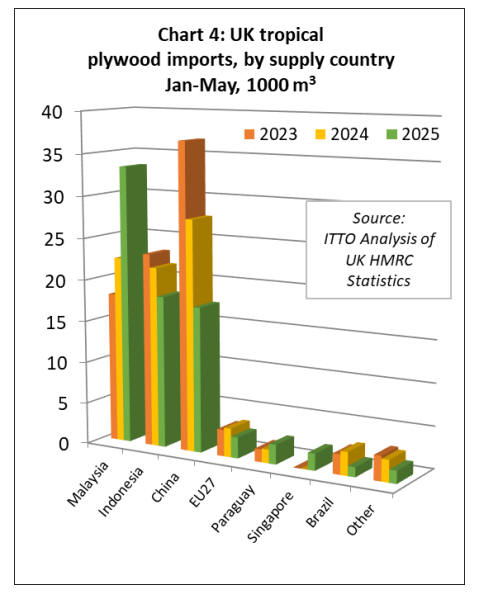
Republic of Congo takes larger share of UK tropical
sawnwood market
UK imports of tropical sawnwood were 38,800 cu.m in the
first five months of this year, 3% more than the same
period last year. Import value also increased by 3% to
US$48 million during the period. The most notable trend
this year has been a sharp rise in imports from the
Republic of Congo which increased 128% to 9,100 cu.m
in the first five months of this year.
Less dramatic increases were recorded in imports from
Malaysia (+10% to 4,800 cu.m), Brazil (+1% to 1,300
cu.m), and Guyana (+28% to 500 cu.m).
Meanwhile imports from Cameroon, still the largest
supplier to the UK but now only just ahead of the Republic
of Congo, were down 17% to 11,200 cu.m in the first five
months of this year. Indirect imports from the EU were
9,700 cu.m, 1% less than the same period last year.
(Chart5).
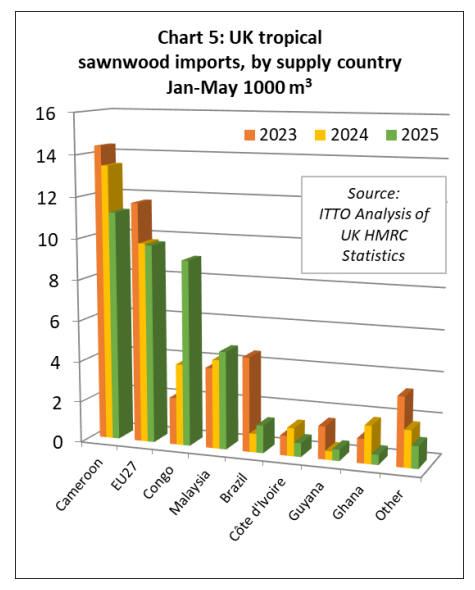
UK imports of tropical hardwood mouldings/decking
increased 7% to 3,800 tonnes in the first five months of
this year. Import value was up 6% to US$10.6 million.
Much of the gain was due to a rise in imports from EU
countries, up 83% to 800 tonnes, and from Vietnam which
gained 187% to 400 tonnes during the five-month period.
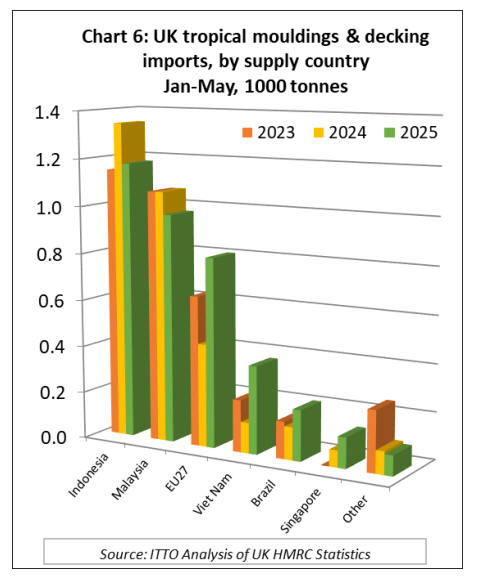
UK imports of this commodity from Indonesia fell by 13%
to 1,200 tonnes and were down 9% from Malaysia to
1,000 tonnes (Chart 6 above).
Marginal gain in tropical share of UK wood product
imports
The UK market for tropical wood and wooden furniture
products in the first five months of this year performed
marginally better than the wider UK market for wood and
wooden furniture products.
In real terms (accounting for inflation), total UK import
value of these products increased 4% to US$4.57 billion in
the first five months of 2025, while the value of tropical
product imports increased by 5% to $442 million during
this period.
The share of tropical wood and wooden furniture products
in total UK imports increased slightly from 9.6% in the
first five months of 2024 to 9.7% during the same period
this year. However, it was still down on the 11.4% share
achieved in 2022 and the close to 14% share typical before
the COVID pandemic (Chart 7).
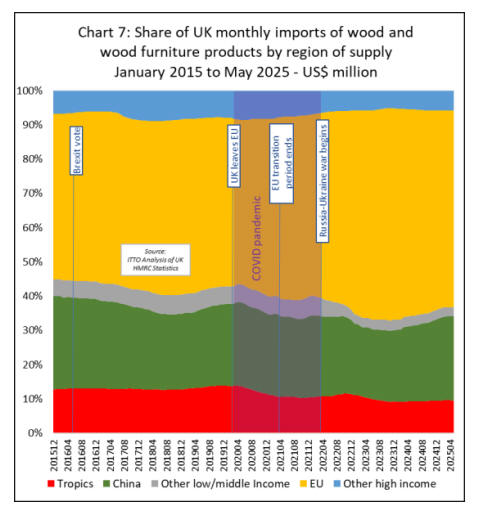
UK imports of this commodity from Indonesia fell by 13%
to 1,200 tonnes and were down 9% from Malaysia to
1,000 tonnes (Chart 6 above).
Marginal gain in tropical share of UK wood product
imports
The UK market for tropical wood and wooden furniture
products in the first five months of this year performed
marginally better than the wider UK market for wood and
wooden furniture products.
In real terms (accounting for inflation), total UK import
value of these products increased 4% to US$4.57 billion in
the first five months of 2025, while the value of tropical
product imports increased by 5% to $442 million during
this period.
The share of tropical wood and wooden furniture products
in total UK imports increased slightly from 9.6% in the
first five months of 2024 to 9.7% during the same period
this year. However, it was still down on the 11.4% share
achieved in 2022 and the close to 14% share typical before
the COVID pandemic (Chart 7).
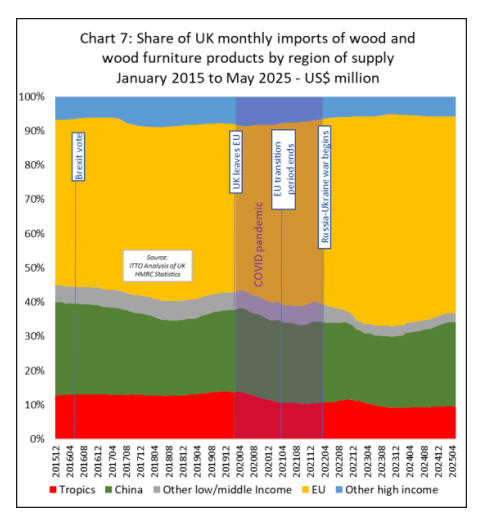
|